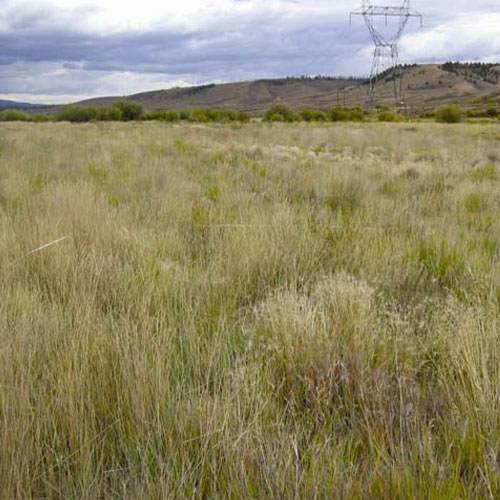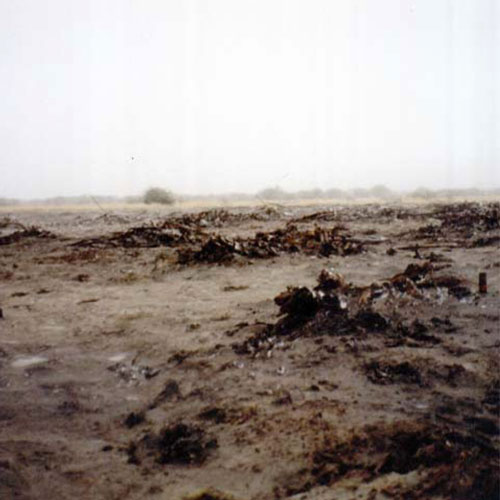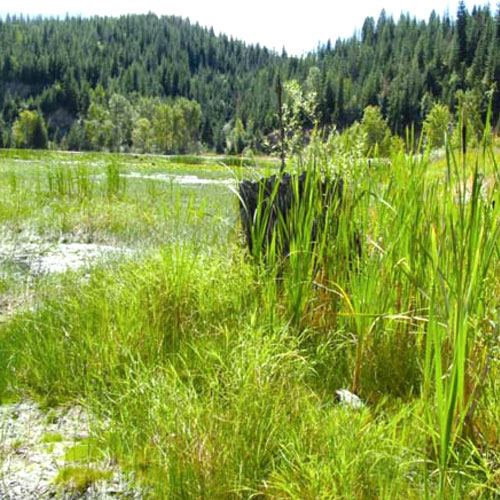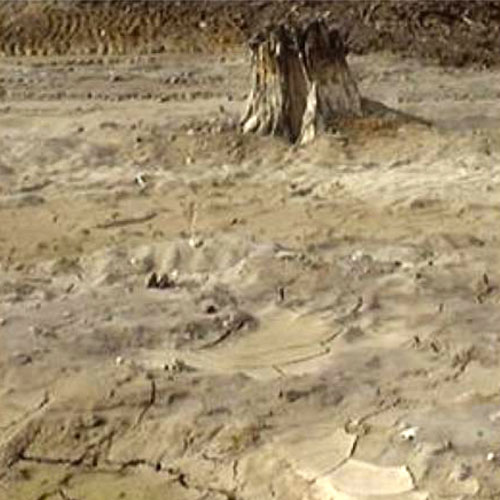
Soil Amendments
- Home
- EPA Presentations
- Principles for Ecological Land Reuse
- Soil Science
- Soil Amendments
- Why is soil health important?
- What are soil amendments?
- What is compost?
- What are biosolids?
- Further Information and Resources
- EPA Resources Related to the Reuse of Industrial Non-hazardous Materials
- Further Information and Resources on Biosolids
- Terrestrial Carbon Sequestration
- Plants and Revegetation
- Growing Gardens in Urban Soils
- Ecosystem Services
- Creating Pollinator Habitats as Part of an Ecological Revitalization Project
- Act Locally
- Land Revitalization Assistance
- Case Study Profiles
- Publications, Resources, and Links
- Glossary of Ecological Land Reuse Terms
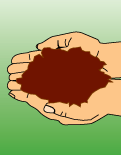
Why is soil health important?
All components of an ecosystem are dependent on viable and healthy soils for the system to function properly. Increased acidity, the presence of heavy metals and other contaminants, and high concentrations of salts can render a soil infertile by inhibiting plant growth, limiting microbial activity, and altering its physical properties. Therefore, it is critical to revitalize soil health in order to restore a degraded ecosystem. In many cases, adding soil amendments such as compost, manure, or lime can revitalize soil by adjusting pH, addressing chemical imbalances, and improving soil texture and structure.
What are soil amendments?
Some treatments involve adding soil amendments to the contaminated media. Soil amendments are materials added to soils in order to revitalize and make them suitable for sustaining plant life or development. Superfund sites and other sites with contaminated or disturbed soils exhibit a variety of problems that often can be addressed effectively and directly through the use of soil amendments. Project managers could evaluate their effects in the subsurface, their potential for eventual transport to surface waters, and their possible subsequent adverse effects on plant and animal communities.
Compost and biosolids are among the most commonly used soil amendments. Other amendments include manure, digestates, sludges, yard waste, and ethanol production by-products. Inorganic amendments include lime, wood ash, coal combustion products, foundry sands, steel slag, dredged materials, and water treatment residuals.
For additional information on soil amendments, please visit the EPA publication The Use of Soil Amendments for Remediation, Revitalization, and Reuse.
What is compost?
Compost is a biologically stable soil amendment produced by the aerobic decomposition of organic materials. Organic (carbon-based) materials include grass clippings, leaves, yard and tree trimmings, food scraps, crop residues, animal manure, and biosolids.
Compost is a valuable soil amendment as it enriches and builds healthy soil. By applying compost to the soil, it:
- Adds organic matter to the soil and increases the nutrient content and biodiversity of microbes in soil.
- Conserves water and reduces water use by helping soils retain moisture.
- Helps prevent soil erosion by reducing soil compaction and runoff.
- Reduces reliance on chemical fertilizers and pesticides.
- Improves plant growth and promotes higher yields of agricultural crops.
- Improves water quality by filtering stormwater and reduces nutrient and sediment runoff.
- Helps regenerate poor soil and remediates (clean up) soils that have been depleted by overuse or contain contaminants.
By composting organic materials, and then using that compost in the soil, a sustainable, closed loop system is created, as those materials are recycled back into the earth.
For more information on composting and compost use, visit the EPA Composting webpages:
What are biosolids?
Biosolids are the nutrient-rich organic materials resulting from the treatment of sewage sludge (the name for the solid, semi-solid or liquid untreated residue generated during the treatment of domestic sewage in a treatment facility). When treated and processed, sewage sludge can be safely recycled and used as a soil amendment. These biosolids can help maintain productive soils and stimulate plant growth in a sustainable fashion. However, only biosolids that meet stringent Federal and state standards can be approved for use as soil amendments. Now, through a Voluntary Environmental Management System developed by the National Biosolids Partnership (NBP), community-friendly practices also will be followed.
EPA provides the public with educational information, based on the best science, about the safe recycling and disposal of biosolids. To access this information, please visit the EPA Biosolids web page:
Further Information and Resources on Soil Amendments (General)
- A Review on Remediation of Iron Ore Mine Tailings Via Organic Amendments Coupled with Phytoremediation
Sarathchandra, S.S., Z. Rengel, and Z.M. Solaiman, Plants 12:1871(2023)
Existing physical, chemical, and amendment-assisted phytoremediation methods to rehabilitate mine tailings are compared from cost, reliability, and durability perspectives. The review concludes that amendment-assisted phytoremediation has received comparatively great attention; however, the selection of an appropriate phytoremediator is a critical step in the process. Moreover, phytoremediation efficiency is solely dependent on the amendment type and rate. Applying advanced plant improvement technologies, such as genetically engineered plants produced for this purpose, would be an alternative solution. - Restoration of Mine Tailings Site Using Soil Amendments
This research brief describes a study by the University of Arizona Superfund Research Program where the use of soil amendments led to the successful stabilization and revitalization of land contaminated with mine tailings at the Humboldt Smelter Superfund sitem. Adding soil amendments led to the establishment and sustained growth of native plants over four years. - Soil Amendment Applications and Mine Site Restoration Impacts on Soil Ecosystem Services
U.S. EPA, 2014
This webinar was presented as part of the CLU-IN mining webinar series. Dr. Sally Brown (University of Washington) and Andrew Trlica (Southern Illinois University) discussed the use of soil amendments, the impact of soil restoration at mine sites on ecosystem function and services, and deliberate decision-making in site restoration that benefits the whole ecosystem. Topics included residuals use for the development of new soil at a Jasper County, MO Superfund site, ecological and economic values of using residuals, and soil carbon storage at areas reclaimed with biosolids-based soil amendments compared to areas reclaimed using conventional approaches. - Soil Amendments for Site Remediation & Reuse: A Cost-Effective In Situ Technology

U.S. EPA, 2011, 1.3MB
This fact sheet provides information on soil amendments as a tool for remediation and revegetation. It also provides information on technical assistance provided by the EPA Office of Superfund Remediation and Technology Innovation. - The Use of Soil Amendments for Remediation, Revitalization, and Reuse

U.S. EPA, December 2007, 1.6MB
This paper provides information on the use of a variety of soil amendments and their use for remediation, revitalization, and reuse of many types of disturbed and contaminated landscapes. Considerations for use of biosolids are given in this report. - Kansas State University interview with Dr. Sally Brown, Soil Scientist, University of Washington
Dr. Sally Grown, Sail Scientist, University of Washington, 2011
Dr. Brown discusses the use of biosolids as soil amendments to remediate contaminated land and improve soil at both the large scale and small urban gardens. - Soil Amendments for Remediation, Revitalization, and Reuse Tools

U.S. EPA, 2007, 2.2MB
This fact sheet describes two tools developed by U.S. EPA in cooperation with 18 federal and local government, academic, and private sector experts. These tools are designed to encourage and assist site cleanup managers to use soil amendments for remediation, revitalization, and reuse of their sites resulted from this collaboration.
- Soil Remediation, Revitalization, and Reuse: Technical Performance Measures
The purpose of this website is to provide a tool to assist site project managers in the selection of appropriate technical performance measures (TPMs) for evaluating the remedial success of soil amendments used for remediation, revitalization, and reuse of contaminated sites.
EPA Resources Related to the Reuse of Industrial Non-hazardous Materials
- Sustainable Management of Industrial Non-Hazardous Materials
The beneficial use of industrial non-hazardous secondary materials is a key part of EPA's Sustainable Materials Management (SMM) effort. The appropriate beneficial use of secondary materials can advance the goals of EPA's SMM program, which emphasizes a materials management approach that aims to reduce impacts to human health and the environment associated with materials over their entire life cycle. - Methodology for Evaluating Beneficial Uses of Industrial Non-Hazardous Secondary Materials and the Beneficial Use Compendiums
This document presents EPA's approach for evaluating a wide range of industrial non-hazardous secondary materials and their associated beneficial uses. - Risk Assessment of Spent Foundry Sands in Soil-Related Applications
This risk assessment concluded that the beneficial uses of silica-based spent foundry sands, when used in manufactured soils, soil-less potting media, and roadway subbase, are protective of human health and the environment. Based on this conclusion, and the available environmental and economic benefits, the EPA and US Department of Agriculture (USDA) support the beneficial use of silica-based spent foundry sands specifically from iron, steel and aluminum foundry operations when used in manufactured soils, soil-less potting media and roadway subbase. - Report: EPA Promoted the Use of Coal Ash Products with Incomplete Risk Information
A report from the EPA Office of Inspector General to determine whether EPA followed acceptedd and standard practices in determining that coal combustion residuals (CCRs) are safe for the beneficial uses it had promoted on its Coal Combustion Products Partnership (C2P2) program website.
Further Information and Resources on Biosolids
Remediating Contaminated Land Using Biosolids as a Soil Amendment
- Biosolids Recycling: Restore, Reclaim, Remediate
This film by the EPA Environmental Response Team outlines the use of biosolids as a remediation tool for contaminated lands and former mining sites.
- Bioavailability-Based Remediation of Metals Using Soil Amendments: Considerations & Evaluation Techniques
U.S. EPA, 2011
This is a two-part cluin.org webinar series presented by Dr. Kirk Scheckel, Dr. Nick Basta, Dr. Rufus Chaney, and Dr. Mark Sprenger on bioavailablity based performance measures for using soil amendments such as biosolids for remediation and reuse.
View Part 1
View Part 2 - Using Biosolids and Coal Combustion Products for Soil Remediation at Mining Sites
U.S. EPA, 2011
This webinar was presented as part of the CLU-IN mining webinar series. Dr. W. Lee Daniels (Virginia Tech) discussed utilizing biosolids as a soil amendment for mined land reclamation, remediation and revegetation of phytotoxic materials with biosolids and lime, and potentials and issues for use of coal combustion residuals in mined land reclamation. All three presentations included case study data and findings that are supported by publications available at www.landrehab.org.
- Biosolids Recycling: Restore, Reclaim, Remediate
EPA Notices of Policy
- A Statement of Federal Policy and Guidance: Land Application of Municipal Sewage Sludge for the Production of Fruits and Vegetables

U.S. EPA, Food and Drug Administration, Department of Agriculture, 1981, 8.33MB
This document provides a coordinated federal prospective on the use of municipal wastewater sludge in fruit and vegetable crop production. The document also provides technical guidance regarding how to minimize potential risks posed by the use of municipal wastewater sludge in fruit and vegetable crop production.
- A Statement of Federal Policy and Guidance: Land Application of Municipal Sewage Sludge for the Production of Fruits and Vegetables
Land Application of Biosolids
- Biosolids Recycling: Beneficial Technology for a Better Environment

U.S. EPA�s Office of Water, 1994, 3.73MB
This booklet was published to help provide an understanding of the great value that can be derived from the beneficial use if biosolids. Additionally, the booklet discusses and reaffirms EPA�s policy that encourages the beneficial use biosolids. - Biosolids Technology Fact Sheet Land Application of Biosolids

U.S. EPA, September 2000, 531KB
This fact sheet discusses the advantages and benefits of recycling biosolids through land application. - Use and Disposal of Biosolids (Sewage Sludge)
U.S. EPA This EPA website provides detailed information related to the use and disposal of biosolids, and provides links to additional EPA biosolids resources. - Biosolids Applied to Land: Advancing Standards and Practices

National Research Council, 2002, 1MB
The Clean Water Act (CWA) requires EPA to review sewage sludge regulations every two years. To address these concerns and fulfill its commitments under the CWA, EPA commissioned the NRC of the National Academy of Sciences to independently review the scientific basis of the regulations governing the land application of sewage sludge. This report summarizes the NRC�s findings and concludes that there is no documented scientific evidence that sewage sludge regulations have failed to protect public health, but there is persistent uncertainty on possible adverse health effects. - Fertilizing with Biosolids

Dan M. Sullivan et al, Revised 2022, 1MB
This publication focuses on how biosolids can be used to supply nutrients for crop production. This document also addresses biosolids quality factors, applicable regulations, and questions about biosolids safety and application practices. - Land Application and Composting of Biosolids
Water Environment Federation, 2010, 114KB
This fact sheet provides commonly asked questions and answers related to the land application and composting of biosolids. Some of the topics covered include an introduction to biosolids, and the benefits and common safety concerns associated with biosolids land application. - Potential Uses of Biosolids Fact Sheet
Water Environment Federation, 2013, 243KB
This fact sheet presents basic information about biosolids and discusses the many benefits and potential uses of biosolids applications. - Questions and Answers about Biosolids Recycling
Rocky Mountain Water Environment Association, 2002, 354KB
This brochure presents basic information regarding biosolids. Specifically, the document discusses common uses and methods of biosolids application, and addresses safety concerns associated with the land application of biosolids. - Water Environment Federation
Water Environment Federation
This website includes several fact sheets related to the land application of biosolids. Some of the topics covered by the fact sheets include basic biosolid information, biosolids management, the history of biosolids, and emerging biosolids treatment practices. Disclaimer: EPA does not endorse the information presented on this website and provides information about this website purely as a reference.
- Biosolids Recycling: Beneficial Technology for a Better Environment
Technical Information Related to Biosolids and Why Land Application of Biosolids is Considered Safe
- A Guide to the Biosolids Risk Assessments for the EPA Part 503 Rule

EPA's Office of Wastewater Management, 1995, 12.5MB
This document was prepared to help the public, wastewater treatment authorities, state regulators and scientists better understand the risk assessment process that was conducted as a basis for the Part 503 biosolids rule. The Guide emphasizes the importance of collecting relevant data and using appropriate models and assumptions in the establishment of pollutant limits and management practices that protect public health and the environment from reasonably anticipated adverse effects of pollutants in biosolids. - A Plain English Guide to the EPA Part 503 Biosolids Rule

EPA's Office of Wastewater Management, 1994, 35.2MB
This document provides a detailed overview of biosolids and of the Part 503 rule, its risk assessment basis and rule requirements. The Guide states that because biosolids are typically treated before being land applied, their use poses a low degree of risk. The Guide reiterates EPA's long-standing position that the beneficial application of biosolids to provide crop nutrients or to condition the soil is not only safe but good public policy, so long as preparers and land appliers comply with all applicable requirements of the Part 503 rule. - Final Action Not to Regulate Dioxins in Land-Applied Sewage Sludge
U.S. EPA
This webpage discusses EPA's evaluation of potential human exposure and risk to dioxins from land-applied sewage sludge. EPA concluded that currently available information on dioxin exposures, toxicity, and cancer risks supports the decision that no numeric limits or management practices are required to adequately protect human health and the environment from the adverse health effects of dioxins in land-applied sewage sludge. - HJR 694 Biosolids Expert Panel Final Review

Virginia Secretary of Natural Resources and Secretary of Health and Human Resources, 2008, 719KB
In accordance with House Joint Resolution No. 694, the Virginia Secretary of Natural Resources and Secretary of Health and Human Resources convened a Panel of experts in 2007 to study the impact of land application of biosolids on human health and the environment. The General Assembly posed specific questions to the Panel and requested that they consider the typical contaminant concentrations and application rates of biosolids in their responses. This report summarizes the panel's findings and recommendations.
- A Guide to the Biosolids Risk Assessments for the EPA Part 503 Rule
Resources/Tools for Site Managers
- Biosolids and Residuals Management Fact Sheet: Odor Control in Biosolids Management

U.S. EPA's Office of Water, 2000, 82.9KB
This Fact Sheet provides information on the control of odors from biosolids production facilities, and the prevention of odors from the storage, distribution, and application of the biosolids product. - Control of Pathogens and Vector Attraction in Sewage Sludge

U.S. EPA, 2003, 4.67MB
This document is intended to serve as a guide to pathogen and vector attraction reduction for anyone who is involved with the treatment of sewage sludge for land application. - Process Design Manual for Land Application of Municipal Sludge

U.S. EPA, 1983, 22.9MB
This document provides general guidance and basic information for use in planning, designing and operating projects for land application of sludge in agricultural and forest land utilization, at drastically disturbed land areas, and at high rate dedicated land disposal sites. The document also provides detailed information about the advantages and disadvantages of all of the above land application scenarios, as well as suggests possible solutions to potential problems/issues associated with each scenario.
- Biosolids and Residuals Management Fact Sheet: Odor Control in Biosolids Management
Examples of Biosolids Application
- Poland Biosolids Smelter Waste Reclamation Project

U.S. EPA, 2000, 391KB
This brochure describes the background, methodology, results and benefits of a unique biosolids remediation project that occurred in Poland from 1994, through 1999. By applying a mixture of biosolids and waste lime to some highly toxic smelter and coal waste piles, the project developed an inexpensive technique to revegetate previously barren land. - Biosolids Success Stories: Carbon County, Pennsylvania- Reclamation of Palmerton Zinc Superfund Site

Water Environment Federation, 2000, 149KB
This document describes the successful remediation of the Palmerton Zinc Superfund Site through the application of biosolids, limestone, potash and fly ash. The success story also states that this use of municipal biosolids offers the potential to reclaim similar contaminated sites and also provide a viable and useful method of recycling municipal biosolids and power plant fly ash. - Land Application of Municipal Biosolids
U.S.G.S., 2014
The application of municipal biosolids on land may be a widespread source of emerging contaminants to surface and ground water. The USGS created this webpage to provide information about the land application of municipal biosolids including current projects the USGS scientists are conducting.
- Poland Biosolids Smelter Waste Reclamation Project



